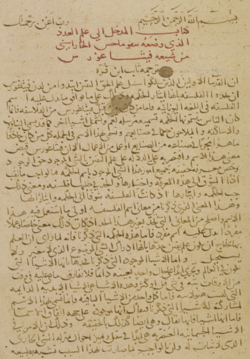Introduction to Arithmetic

The book Introduction to Arithmetic (Greek: Ἀριθμητικὴ εἰσαγωγή, Arithmetike eisagoge) is the only extant work on mathematics by Nicomachus (60–120 AD).
Summary
The work contains both philosophical prose and basic mathematical ideas. Nicomachus refers to Plato quite often, and writes that philosophy can only be possible if one knows enough about mathematics. Nicomachus also describes how natural numbers and basic mathematical ideas are eternal and unchanging, and in an abstract realm. It consists of two books, twenty-three and twenty-nine chapters, respectively.
Although he was preceded by the Babylonians and the Chinese,[1] Nicomachus provided one of the earliest Greco-Roman multiplication tables, whereas the oldest extant Greek multiplication table is found on a wax tablet dated to the 1st century AD (now found in the British Museum).[2]
Influence
The Introduction to Arithmetic of Nicomachus was a standard textbook in Neoplatonic schools and become the basis of the Boethius' treatise titled De institutione musica.[3]
The Arithmetic (in Latin: De Institutione Arithmetica) of Boethius was a Latin paraphrase and a partial translation of the Introduction to Arithmetic.[4] The work of Boethius on arithmetic and music was exposed in the context of the Quadrivium liberal arts and had a great diffusion during the Middle Age.[5]
Editions
- Nicomachus of Gerasa Introduction to arithmetic, translated into English by Martin Luther D'Ooge; with studies in Greek arithmetic by Frank Egleston Robbins and Louis Charles Karpinski, University of Michigan studies (London: Macmillan, 1926).
- Nicomachus of Gerasa Introduction to arithmetic, translated into English by Martin Luther D'Ooge; with studies in Greek arithmetic by Frank Egleston Robbins and Louis Charles Karpinski (London: Johnson Reprint Corp., 1972).
See also
References
- ↑ Qiu, Jane (January 7, 2014). "Ancient times table hidden in Chinese bamboo strips". Nature News. doi:10.1038/nature.2014.14482. http://www.nature.com/news/ancient-times-table-hidden-in-chinese-bamboo-strips-1.14482.
- ↑ David E. Smith (1958), History of Mathematics, Volume I: General Survey of the History of Elementary Mathematics, New York: Dover Publications (a reprint of the 1951 publication), ISBN:0-486-20429-4, pp 58, 129.
- ↑ Arnold, Jonathan; Bjornlie, Shane; Sessa, Kristina (April 18, 2016). A Companion to Ostrogothic Italy. Brill's Companions to European History. Brill. p. 332. ISBN 9789004315938. OCLC 1016025625. https://books.google.com/books?id=48wJDAAAQBAJ&pg=PA332. Retrieved May 16, 2021.
- ↑ Edward Grant (1974). A Source Book in Medieval Science. Source books in the history of the sciences. 13. Harvard University Press. p. 17. ISBN 9780674823600. OCLC 1066603. https://books.google.com/books?id=fAPN_3w4hAUC&pg=PA17.
- ↑ Ivor Bulmer-Thomas (April 1, 1985). "Boethian Number Theory - Michael Masi: Boethian Number Theory: A Translation of the De Institutione Arithmetica (with Introduction and Notes)". The Classical Review (The Classical Association, Harvard University Press) 35 (1): 86–87. doi:10.1017/S0009840X00107462. https://www.cambridge.org/core/journals/classical-review/article/abs/boethian-number-theory-michael-masi-boethian-number-theory-a-translation-of-the-de-institutione-arithmetica-with-introduction-and-notes-studies-in-classical-antiquity-6-pp-198-8-figures-with-mathematical-diagrams-and-musical-notation-in-text-amsterdam-editions-rodopi-1983-paper-fl-60/65CB044CD9E4688B98D23D37E9915443.
Bibliography
- Archivistic sources
- Boethius (1488) (in Latin). De institutione arithmetica. Erhard Ratdolt. pp. 110. https://archive.org/details/ita-bnc-in1-00000520-001/page/n13/mode/2up?q=nicomac.
External links
- Nicomachus' "Introduction to Arithmetic", translated by Martin Luther D'Ooge at archive.org.
- Nicomachus of Gerasa: Introduction to Arithmetic (1926) translated in English by Martin Luther D'Ooge with studies in Greek arithmetic by Frank Egleston Robbins and Louis Charles Karpinski at Haithi Trust Digital Library

